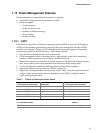
Intel Desktop Board D810EMO/MO810E Technical Product Specification
20
1.6.3 IDE Support
The board has two independent bus-mastering IDE interfaces. These interfaces support:
• ATAPI devices (such as CD-ROM drives)
• ATA devices using the transfer modes listed in Table 51 on page 79
The BIOS supports logical block addressing (LBA) and extended cylinder head sector (ECHS)
translation modes. The drive reports the transfer rate and translation mode to the BIOS.
The board supports laser servo (LS-120) diskette technology through its IDE interfaces. The
LS-120 drive can be configured as a boot device by setting the BIOS Setup program’s Boot menu
to one of the following:
• ARMD-FDD (ATAPI removable media device – floppy disk drive)
• ARMD-HDD (ATAPI removable media device – hard disk drive)
The board has two IDE interface connectors. The primary IDE connector is a standard 40-pin IDE
interface. The secondary IDE connector is a 50-pin Slimline IDE connector, intended for use with
devices such as 2.5-inch hard disk drives and mobile CD-ROM drives. The Slimline IDE
connector has the standard IDE interface pins but also includes audio and power signals.
For information about Refer to
The location of the IDE connectors Figure 5, page 41
The signal names of the primary IDE connector Table 24, page 42
The signal names of the Slimline secondary IDE connector Table 25, page 43
BIOS Setup program’s Boot menu Table 56, page 85
1.6.4 Real-Time Clock, CMOS SRAM, and Battery
The real-time clock is compatible with DS1287 and MC146818 components. The clock provides a
time-of-day clock and a multicentury calendar with alarm features and century rollover. The
real-time clock supports 256 bytes of battery-backed CMOS SRAM in two banks that are reserved
for BIOS use.
A coin-cell battery powers the real-time clock and CMOS memory. When the computer is not
plugged into a wall socket, the battery has an estimated life of three years. When the computer is
plugged in, the 3.3 V standby current from the power supply extends the life of the battery. The
clock is accurate to ± 13 minutes/year at 25 ºC with 3.3 VSB applied.
The time, date, and CMOS values can be specified in the BIOS Setup program. The CMOS values
can be returned to their defaults by using the BIOS Setup program.
✏
NOTE
If the battery and AC power fail, standard defaults, not custom defaults, will be loaded into CMOS
RAM at power on.


















